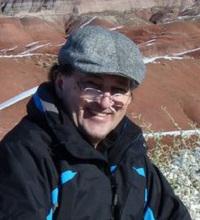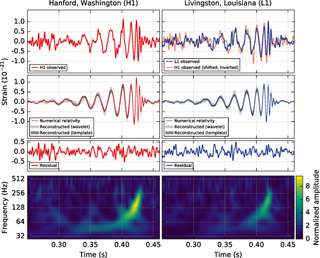
Physical cosmology is a branch of cosmology concerned with the study of cosmological models. A cosmological model, or simply cosmology, provides a description of the largest-scale structures and dynamics of the universe and allows study of fundamental questions about its origin, structure, evolution, and ultimate fate. Cosmology as a science originated with the Copernican principle, which implies that celestial bodies obey identical physical laws to those on Earth, and Newtonian mechanics, which first allowed those physical laws to be understood.

In physical cosmology, the Copernican principle states that humans, on the Earth or in the Solar System, are not privileged observers of the universe, that observations from the Earth are representative of observations from the average position in the universe. Named for Copernican heliocentrism, it is a working assumption that arises from a modified cosmological extension of Copernicus' argument of a moving Earth.
In astronomy, dark matter is a hypothetical form of matter that appears not to interact with light or the electromagnetic field. Dark matter is implied by gravitational effects which cannot be explained by general relativity unless more matter is present than can be seen. Such effects occur in the context of formation and evolution of galaxies, gravitational lensing, the observable universe's current structure, mass position in galactic collisions, the motion of galaxies within galaxy clusters, and cosmic microwave background anisotropies.
The study of galaxy formation and evolution is concerned with the processes that formed a heterogeneous universe from a homogeneous beginning, the formation of the first galaxies, the way galaxies change over time, and the processes that have generated the variety of structures observed in nearby galaxies. Galaxy formation is hypothesized to occur from structure formation theories, as a result of tiny quantum fluctuations in the aftermath of the Big Bang. The simplest model in general agreement with observed phenomena is the Lambda-CDM model—that is, that clustering and merging allows galaxies to accumulate mass, determining both their shape and structure. Hydrodynamics simulation, which simulates both baryons and dark matter, is widely used to study galaxy formation and evolution.

In cosmology, the cosmological constant, alternatively called Einstein's cosmological constant, is the constant coefficient of a term that Albert Einstein temporarily added to his field equations of general relativity. He later removed it, however much later it was revived and reinterpreted as the energy density of space, or vacuum energy, that arises in quantum mechanics. It is closely associated with the concept of dark energy.
In modern physical cosmology, the cosmological principle is the notion that the spatial distribution of matter in the universe is uniformly isotropic and homogeneous when viewed on a large enough scale, since the forces are expected to act equally throughout the universe on a large scale, and should, therefore, produce no observable inequalities in the large-scale structuring over the course of evolution of the matter field that was initially laid down by the Big Bang.
A non-standard cosmology is any physical cosmological model of the universe that was, or still is, proposed as an alternative to the then-current standard model of cosmology. The term non-standard is applied to any theory that does not conform to the scientific consensus. Because the term depends on the prevailing consensus, the meaning of the term changes over time. For example, hot dark matter would not have been considered non-standard in 1990, but would have been in 2010. Conversely, a non-zero cosmological constant resulting in an accelerating universe would have been considered non-standard in 1990, but is part of the standard cosmology in 2010.

A supermassive black hole is the largest type of black hole, with its mass being on the order of hundreds of thousands, or millions to billions, of times the mass of the Sun (M☉). Black holes are a class of astronomical objects that have undergone gravitational collapse, leaving behind spheroidal regions of space from which nothing can escape, including light. Observational evidence indicates that almost every large galaxy has a supermassive black hole at its center. For example, the Milky Way galaxy has a supermassive black hole at its center, corresponding to the radio source Sagittarius A*. Accretion of interstellar gas onto supermassive black holes is the process responsible for powering active galactic nuclei (AGNs) and quasars.
The Big Bounce hypothesis is a cosmological model for the origin of the known universe. It was originally suggested as a phase of the cyclic model or oscillatory universe interpretation of the Big Bang, where the first cosmological event was the result of the collapse of a previous universe. It receded from serious consideration in the early 1980s after inflation theory emerged as a solution to the horizon problem, which had arisen from advances in observations revealing the large-scale structure of the universe.
In astroparticle physics, an ultra-high-energy cosmic ray (UHECR) is a cosmic ray with an energy greater than 1 EeV (1018 electronvolts, approximately 0.16 joules), far beyond both the rest mass and energies typical of other cosmic ray particles.
The Lambda-CDM, Lambda cold dark matter, or ΛCDM model is a mathematical model of the Big Bang theory with three major components:
- a cosmological constant, denoted by lambda (Λ), associated with dark energy
- the postulated cold dark matter, denoted by CDM
- ordinary matter
The gravitational wave background is a random background of gravitational waves permeating the Universe, which is detectable by gravitational-wave experiments, like pulsar timing arrays. The signal may be intrinsically random, like from stochastic processes in the early Universe, or may be produced by an incoherent superposition of a large number of weak independent unresolved gravitational-wave sources, like supermassive black-hole binaries. Detecting the gravitational wave background can provide information that is inaccessible by any other means about astrophysical source population, like hypothetical ancient supermassive black-hole binaries, and early Universe processes, like hypothetical primordial inflation and cosmic strings.

Fulvio Melia is an Italian-American astrophysicist, cosmologist and author. He is professor of physics, astronomy and the applied math program at the University of Arizona and was a scientific editor of The Astrophysical Journal and an associate editor of The Astrophysical Journal Letters. A former Presidential Young Investigator and Sloan Research Fellow, he is the author of six English books and 230 refereed articles on theoretical astrophysics and cosmology.

Gravitational-wave astronomy is a subfield of astronomy concerned with the detection and study of gravitational waves emitted by astrophysical sources.
In physical cosmology and astronomy, dark energy is an unknown form of energy that affects the universe on the largest scales. Its primary effect is to drive the accelerating expansion of the universe. Assuming that the lambda-CDM model of cosmology is correct, dark energy is the dominant component of the universe, contributing 68% of the total energy in the present-day observable universe while dark matter and ordinary (baryonic) matter contribute 26% and 5%, respectively, and other components such as neutrinos and photons are nearly negligible. Dark energy's density is very low: 7×10−30 g/cm3, much less than the density of ordinary matter or dark matter within galaxies. However, it dominates the universe's mass–energy content because it is uniform across space.

In cosmology, primordial black holes (PBHs) are hypothetical black holes that formed soon after the Big Bang. In the inflationary era and early radiation-dominated universe, extremely dense pockets of subatomic matter may have been tightly packed to the point of gravitational collapse, creating primordial black holes without the supernova compression typically needed to make black holes today. Because the creation of primordial black holes would pre-date the first stars, they are not limited to the narrow mass range of stellar black holes.

In cosmology, the steady-state model or steady state theory is an alternative to the Big Bang theory. In the steady-state model, the density of matter in the expanding universe remains unchanged due to a continuous creation of matter, thus adhering to the perfect cosmological principle, a principle that says that the observable universe is always the same at any time and any place.

Vahagn "Vahe" Gurzadyan is an Armenian mathematical physicist and a professor and head of Cosmology Center at Yerevan Physics Institute, Yerevan, Armenia, best known for co-writing "Concentric circles in WMAP data may provide evidence of violent pre-Big-Bang activity" paper with his colleague, Roger Penrose, and collaborating on Roger Penrose's recent book Cycles of Time.
A black hole cosmology is a cosmological model in which the observable universe is the interior of a black hole. Such models were originally proposed by theoretical physicist Raj Pathria, and concurrently by mathematician I. J. Good.









